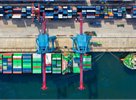
COVID: 2021 Supply Chain Shock and Beyond……................ Hazard a Guess?
Global media coverage surrounding COVID-19 outbreaks provides us with valuable and often detailed information around public health and the initiatives being taken to curtail the spread of the virus. We at ITM wish to add our commentary around the current impact we are observing in the global supply chain through the representation of our clients’ interests around the world.
Current Situation: What we are observing:
Demand:
- Global demand seems to have stabilised as shipping lines report the volume of containers being moved closely resembles 2019’s volumes in Q3. This has not translated to relief in pricing nor reliability of service by the shipping lines partly due to congestion associated with port and terminal closures in battling the Delta variant.
Congestion:
- Shipping lines require more resources in order to move the same amount of freight due to the productivity lost idly waiting for prolonged periods due to congestion in most major ports globally. Delays at port have improved marginally over the last few weeks with further improvement on the way with the President of the United States securing support from port operators to work extended hours to clear backlogs.
Delta Variant:
- During Q3 the Delta variant has had the biggest negative impact on global supply chains causing delays and congestion globally as countries have restricted vital links in the supply chain in order to combat rising infection rates.
Seafreight:
- We have experienced some delays in order fulfillment due to reduced production capacity caused by either limitations to the access of power or closures due to rising infection rates. These have mainly been limited to China and Vietnam.
Airfreight:
- Capacity is still quite low due to travel restrictions with record high airfreight rates reflecting the imbalance between supply and demand. As lockdowns ease and Australia opens up, more flights will return adding much needed capacity to drive rates down. This capacity should impact the market from January onwards when international airlines begin increasing flights to meet rising demand.
Our Advice: Remains Unchanged
Expect rates and capacity to remain at present levels with only a slight chance rates will increase further as we move through this peak season.
My Opinion: Hazard a Guess? I will……..
In time, providing we are not called upon to combat a new variant of concern, I believe the conditions that caused the international supply chain to function inefficiently, thereby creating an opportunity for the shipping lines to make arbitrage profits at the expense of the very clients they serve, will subside, leaving behind excess supply. How and Why?
A shift in consumption patterns away from service industries, namely travel & accommodation (compliments of the pandemic), saw an estimated three trillion dollars a year diverted to the purchase of goods. This created the demand surge that inundated the international supply chain. Then government stimulus was applied to bolster economies around the world and the end result was clear to see, a dysfunctional international supply chain. Now, as we are about to emerge and explore the concept of COVID normal, the world will once again open up to both domestic and international travel diverting those trillions of dollars back to these services and away from goods. In Australia this will begin around the festive season seeing surging demand for vacations within the regions, Interstate and Internationally. I believe we will observe the very same happen when the USA and Europe enter their summer season mid 2022 when capacity will no longer be an issue with flights increasing and regulations around cross border travel eased. We are all planning holidays, are you?
I leave you with some other information for you to consider.
- If sailings are being blanked (i.e. Cancelled) this is a tell-tale sign the shipping lines are struggling to fill their vessels and they will use this tactic to suppress supply to support higher pricing. Keep an eye out!!! I would expect this immediately after Chinese new year.
- Shipping lines are all of a sudden signing global contracts with large multinational clients locking them in for much longer periods. Locking in (higher) prices now, would only be deemed beneficial to the shipping lines if they were anticipating rates to ease moving forward.
- New vessel orders are plentiful and will begin delivering from 2022 onwards. These will add to capacity as any vessel being replaced will be purchased second hand and immediately put in service . More Ships!!!
- Shipping lines purchasing second hand vessels (ZIM) purchased 5 in October 2021. Even more ships!!!
- Construction of new containers is currently being undertaken at the fastest rate ever; estimated at over 200,000 per month. Lots of containers!!!!
- Massive profits will entice new entrants into the shipping line industry. Two new lines have already entered the market this year; admittedly they are small players and operating in a niche trade lanes (China-USA and China- Northern Europe) but it’s a start!!!
- Countries such as the USA, Thailand & Vietnam must consider their export markets and the disruption this has caused. Will we see new entrants backed by government?
- Government budgets need to be repaired all over the world; what does that mean for stimulus and demand?
These are my opinions only and one should look to their trusted adviser for specific advice. It would be all too easy for me to give a blow by blow description of FACT, most of which you have observed first hand in the rates you are charged and the lack of service provided by the shipping lines; this is safe territory for anyone giving advice. I offer the above thoughts in an endeavor to alert you “our clients” to events occurring that will change the status quo.
I believe 2022 will see the balance tip slowly back away from the shipping lines for the very reasons outlined above. No matter how hard the shipping lines try keep freight rates elevated by canceling sailings to meet declining demand they will have to contend with others in their industry that will break ranks and compete on price to secure volume for themselves. They will be encouraged to do so now that the United States government, through its independent agency, the Federal Maritime Commission (FMC) investigating the container shipping industry. Prices will not likely return to pre-pandemic levels as shipping line profits were marginal at best in 2019 and it was becoming increasingly difficult for them to justify their very existence, just as the prices now reflect the polar opposite. Price should steadily decline in 2022 and settle at a point that will preserve service levels, somewhere between the lows of 2019 and highs of 2021.
So have hope, I expect to see a much different International supply chain by the latter half of 2022
We offer our experiences and observations in order to help you to be aware of the impact on the international supply chain and what this means for your orders/production and the impact on your clients.
Rest assured that any developments will be shared with you, but in the meantime feel free to contact your ITM representative with any specific questions you may have.
-
Australian Governments Modern Manufacturing Strategy
-
Boxship owners see 13-year high in charter rates as carriers hunt for tonnage
-
DP World and UNICEF to support COVID-19 vaccine distribution
-
Buoyant ocean carriers set to roll out peak season surcharges months early
-
Trade protectionism a barrier to the recovery of global economies, warns ICS
-
Outlook for large widebody looks chilly in a hot freighter conversion market
-
EVEN AS THE WORLD STRUGGLES
-
Maersk to launch carbon neutral vessel
-
STATE PREMIERS URGED TO INTERVENE ON CROSS-BORDER ISSUES
-
PORT BOTANY RAIL DUPLICATION FAST TRACKED
-
Covid vaccine: is air cargo ready for 'the biggest product launch in history?
-
Logistics protests as Melbourne lockdown puts the brakes on supply chains
-
Demand driving transpacific prices sky high, with Asia-Europe benefiting too
-
Carriers follow through with capacity disicpline and blank more sailings
-
Indonesian Free Trade Agreement - economic opportunity opens up
-
Department of Agriculture turns away import vessel
-
Good Compliance Update - December 2019
-
Scale-less weighing of containers for SOLAS VGM
-
Patrick East Swanson Terminal Melbourne - Reductions in night shift road R&D operations
-
Shippers brace for delays as coronavirus keeps China's factories closed
-
Coronavirus containment measures and the impact on your China cargo.
-
2019/2020 Stink bug seasonal requirements
-
BAF calculator may help ease uncertainty over looming IMO 2020 fuel rule
-
From 15 to 5 in just a few years - shippers' declining choice of container carriers
-
Government money to boost Queensland export
-
Freight forwarding scam warning
-
Marine insurance case study
-
Australian Ports infrastructure not keeping up with global trends
-
Truckies heartened by support to stopping port surcharges
-
Victorian Transport Association (VTA) State Conference 2019 - Making the case for inland rail
-
Protection from tariffs a feature of Australia and Hong Kong deal.
-
BMSB UPDATE 45 - WA Biosecurity Alert
















































